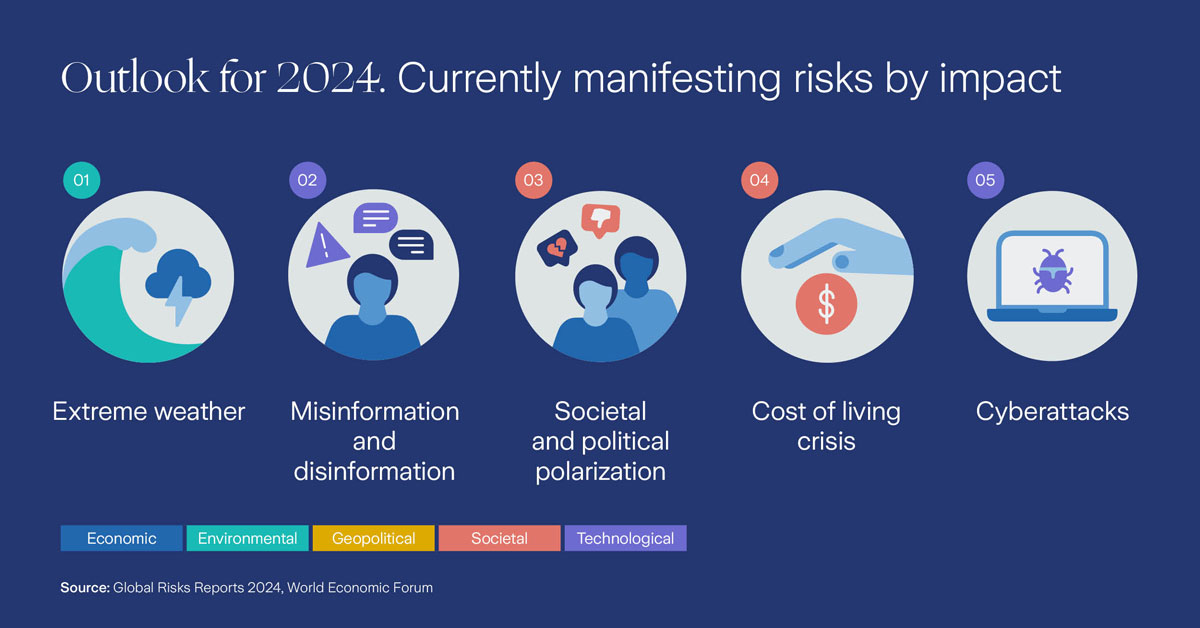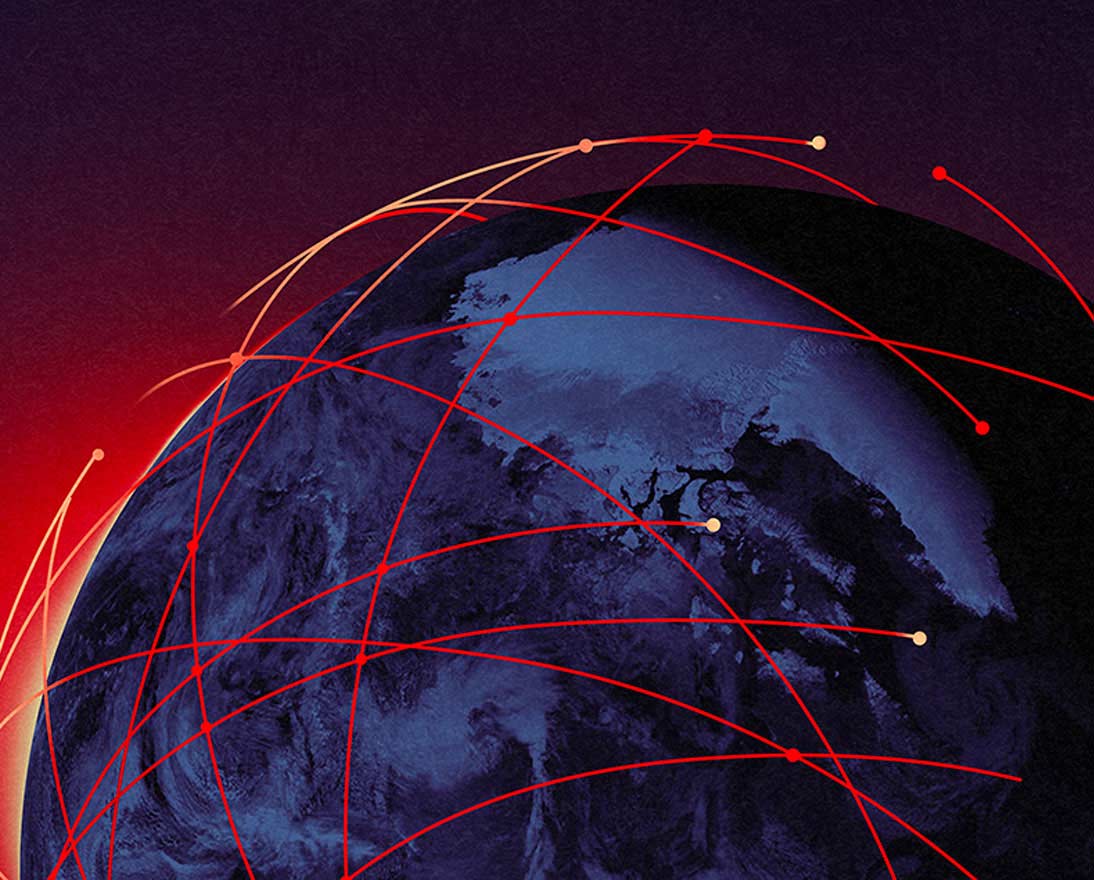The Global Risks Report 2024 - 19th Edition
Global risksArticleJanuary 10, 20245 min read
Drawing on nearly two decades of original risks perception data, the Global Risks Report 2024 warns of a global risks landscape in which progress in human development is being chipped away slowly, leaving states and individuals vulnerable to new and resurgent risks.
The Global Risks Report 2024, developed by the World Economic Forum in collaboration with Zurich and Marsh McLennan, presents the findings of the Global Risks Perception Survey (GRPS), which captures insights from nearly 1,500 global experts. The report analyses global risks through three-time frames to support decision-makers in balancing current crises and longer-term priorities.
As we enter 2024, 2023-2024 GRPS results highlight a predominantly negative outlook for the world over the next two years (84% respondents are concerned) that is expected to worsen over the next decade (92% are pessimistic).
There are four structural forces that will shape the materialization and management of global risks over the next decade. These are longer-term shifts in the arrangement of and relationship between four systemic elements of the global landscape:
- Trajectories relating to global warming and related consequences to Earth systems (Climate change).
- Changes in the size, growth and structure of populations around the world (Demographic bifurcation).
- Developmental pathways for frontier technologies (Technological acceleration).
- Material evolution in the concentration and sources of geopolitical power (Geostrategic shifts).

Environmental risks continue to dominate the risks landscape over all three, time frames. Two-thirds of GRPS respondents rank Extreme weather as the top risk most likely to present a material crisis on a global scale in 2024 with the warming phase of the El Niño-Southern Oscillation (ENSO) cycle projected to intensify and persist until May this year. It is also seen as the second-most severe risk over the two-year time frame. Similar to last year’s rankings, environmental risks dominate the top 4 global risks by severity over a ten year time frame.
Emerging as the most severe global risk anticipated over the next two years (and 5th most impactful risk over ten years) foreign and domestic actors alike will leverage Misinformation and disinformation, further widening societal and political divides. With 3 billion people heading to electoral polls in 2024, the widespread use of misinformation and disinformation, and tools to disseminate it, may undermine the real and perceived legitimacy of newly elected governments. Recent technological advances, such as generative AI, have enhanced the volume, reach and efficacy of falsified information, The longer-term erosion of democratic processes compounded by unrest ranging from violent protests and hate crimes to civil confrontation and terrorism.
Societal polarization features among the top three risks over both the current and two-year time horizons, ranking #9 over the longer term. As polarization grows and technological risks remain unchecked, ‘truth’ will again come under pressure. In addition, Societal polarization and Economic downturn are seen as the most interconnected – and therefore influential – risks in the global risks network, as drivers and possible consequences of numerous risks.
The Cost-of-living crisis remains a major concern in the outlook for 2024. The economic risks of Inflation (#7) and Economic downturn (#9) are also notable new entrants to the top 10 risk rankings over the two-year period. Although a “softer landing” appears to be prevailing for now, the near-term outlook remains highly uncertain. Economic uncertainty will weigh heavily across most markets, but capital will be the costliest for the most vulnerable countries. Climate-vulnerable or conflict-prone countries may be increasingly locked out of much-needed digital and physical infrastructure, trade and green investments and related economic opportunities.
Similarly, the convergence of technological advances and geopolitical dynamics could also create a new set of winners and losers across advanced and developing economies alike. Vulnerable countries and communities could be left further behind, digitally isolated from turbocharged AI breakthroughs impacting economic productivity, finance, climate, education and healthcare, as well as related job creation.
Over the longer-term, continued human development is at risk. Economic, environmental and technological trends could entrench existing challenges around labor and social mobility, blocking individuals from income and skilling opportunities, and therefore the ability to improve economic status.
Simmering geopolitical tensions combined with technology will drive new security risks. As both a product and driver of state fragility, Interstate armed conflict is a new entrant into the top risk rankings over the two-year horizon. This becomes an even more worrying risk when considered in the context of recent technological advances.
Ideological and geoeconomic divides will disrupt the future of governance. A deeper divide on the international stage between multiple poles of power and between the Global North and South could paralyze international governance mechanisms, erode cooperation and divert the attention and resources of major powers away from urgent global risks.
The next decade will be characterized by intense volatility, as we transition through geopolitical, climate, demographic and technological shifts. Cooperation will come under pressure. However there remain key opportunities for action that can be taken locally or internationally, individually or collaboratively – that can significantly reduce the impact of global risks. Localized strategies can reduce the impact of those inevitable risks that we can prepare for, and both the public and private sector can play a key role to extend these benefits to all.
Commercial Insurance Risk Insights
Our experts share their insights on the current risk landscape to help you address and manage emerging risks.




